“An ounce of prevention beats a pound of cure.” In this post, we’ll break down the best way to protect your guitar in the cool months ahead.
Chicago winters kill guitars. The weather gets dry and cold, so we turn on our furnaces – drying out the air in our homes even further. Many will see their indoor relative humidity drop below 20% . That’s 25-30% lower than the factories where guitars are made and the wood just doesn’t like it. Like the skin on our fingertips and the seams on our hardwood floors, dry guitars can crack open without ever being dropped or otherwise mishandled. Other symptoms we see include:
- rough fret ends that stick out past the edge of a fretboard
- loose bridges and braces
- loose neck joints
- separations along the many glue joints that hold a guitar together
- dramatic changes in playing ‘action’
So what can you do to prevent costly repairs to these problems? There’s so many choices hanging in guitar stores that it can be hard to tell which one to buy. Here’s a look at the products that will best help you keep your guitar healthy and happy this winter. You’ll also find a simple formula for how to effectively use them.
We’ve heard some interesting home remedies over the 15 or so years we’ve been working on guitars – from leaving a baggie with a wet sponge in a guitar case to putting an apple or potato inside a case (NOT recommended by this shop!) And we’ve seen lots of products too -from film canister size humidifiers with clay inside to rubber tubes with a sponge inside to space-age devices that can offer protection for months. We’re always looking for answers to this problem and as of 2014, this is our prescription for keeping your guitar properly humidified:
1. Use a good sized room humidifier
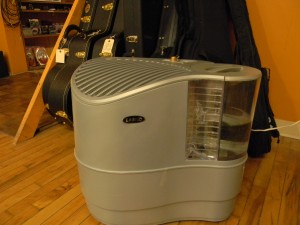
We are of the opinion that case humidifiers are not enough for many guitars. Create an environment that is healthier for you and your guitar by humidifying your home or at least the room where your guitars live. Our shop has Aprilaire humidifiers on our furnaces, but we’ve also grown fond the Lasko humidifiers like the one above because they hold lots of water – enough for a couple of days at least. 40-50% is ideal, but if you can keep the room’s relative humidity over 30%, you will sleep and breathe better, and your guitar-case humidifiers will be able to do the rest. So how do I know if it’s over 30% then, you ask. A digital hygrometer placed near the case will tell you.
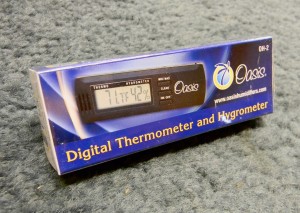
2. Use a guitar case humidifier. CASE being the operative word. These will not work on a stand or wall-hanger. Below are our favorites.
First Choice for Acoustic Guitars – Music Nomad Humitar
($14) The Humitar is a new product from Music Nomad and has quickly become our go-to humidifier this year. It’s simple in operation, durable, and holds enough water to last up to 10 days between refills. It uses a super-absorbant antimicrobial-treated sponge inside a hard plastic container that slips easily between strings in the soundhole. The sponge holds quite a bit of (distilled) water and because of its antimicrobial qualities can last almost indefinitely if kept clean. Replacement sponges are available in case that doesn’t happen. A smaller Ukulele sized Humitar is also available to those who play smaller instruments.
Runner up for Acoustic Guitars – Oasis
($20) We really like these humidifiers. They hold enough distilled water to last from one to two weeks without needing to be refilled. Special crystals inside expand into a super absorbent paste that should be replaced each year (replacement kits are available at CFW for $6.)
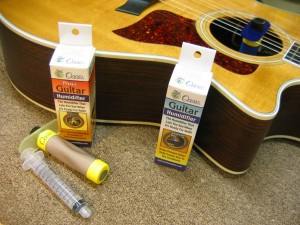
One advantage Oasis holds over every other product is that it will tell you when it’s time to refill by collapsing into a raisin-like appearance that says “Yo! Gettin’ a little dry over here!”
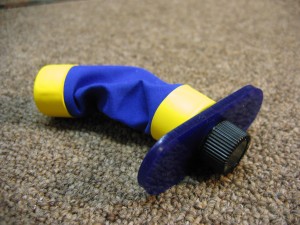
Third (but sometimes first) Choice for Guitars: Planet Waves Two -Way Humidification System (formerly known as Humidipak*)
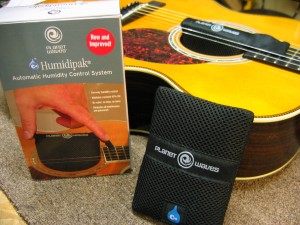
($19) When used with a room humidifier, the Two-Way System is a great product that will keep a constant level of humidity inside your case. Three removable packets hang in black mesh pockets (two for the soundhole and one for behind the headstock,) releasing just enough moisture to keep the inside of your guitar case at a comfortable 48% for up to 3 months. This makes it a fine choice if you don’t play that guitar at least once each week. Because there is moisture is all in those packets, there’s no need for constant refilling with water. It’s also an excellent choice for those who travel with their guitar to different climates because unlike any other product, it will absorb excess moisture if you find yourself in a more humid location.
We do have a couple of concerns about the Humidipak, however. First, it cannot do all of the “heavy lifting” when it comes to humidifying the guitar. If the room it lives in is a dry one, it’s going to work much harder and those packets will dry up within a month. Second, while there’s no refilling a water reservoir every week, the packets do need to be replaced when they dry out and the cost is about $15 for three. We strongly recommend that it be used in conjunction with a regularly maintained furnace or room humidifier. Read more about it at www.planetwaves.com . While you’re there, be sure to check out the video of Bob Taylor from Taylor Guitars to see what he thinks.
For Tight Budgets – Planet Waves Humidifier
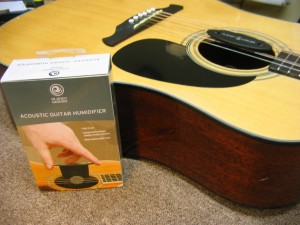
($8) If you play your guitar every day or two and don’t mind refilling a sponge that often, Planet Waves’ original guitar humidifier is the least expensive option. It’ll work as well as the others but will need more attention. The difference between this one and the top-ranked Humitar is the sponge – which in this case holds very little water and dries out within a day or two.
Humidifying F-hole guitars – Humitron/Dampit tube
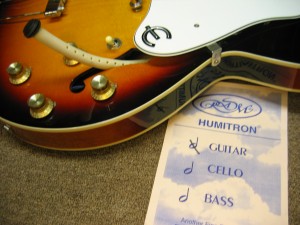
($8) Finally, we do keep a few of the old-style tube humidifiers for guitars and mandolins that have F-holes or for those who just like this style. Fill them up every one to two days.
SUMMARY: The Recipe For Keeping A Guitar Properly Humidified (in Chicago or similar climates:)
- A humidified ROOM
- A FULL case humidifier that is
- Inside the guitar
- Inside the case (NOT hanging on the wall or on a stand.)
- From October through April (or as long as the heat is on in your home)
…Or ignore this advice and come see us in the spring for the best structural repairs anywhere!


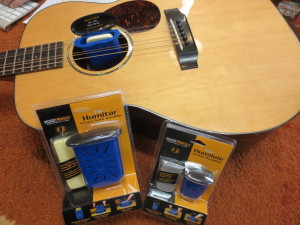
Fyi, I humidify and display guitars at a uniform 45% to 50% RH inside a Musik Tent. It’s an Instrument Humidor that I purchased at a guitar show earlier this year. Seems to work great. –Bill
humidifier with electronic barometer is the coolest thing! the such! Don’t need to worry that will be too damp
need a good humidifier to adjust the humidity, that would not be inadvertently condensate
Thanks for sharing this, I have found that Humidifiers for inside the guitar case solve this problem perfectly. Keeping guitar inside the case not only protects it, but the smaller volume is much easier to humidify than a room or a full house.
Agreed. Around here though we stand by our recommendation to humidify your home too. It’s cumbersome but it helps those little case humidifiers out and it also makes home more comfortable!
The single most important thing you can do to protect your guitar is to learn about humidity control. Thanks for the great advice! I’m currently setting up my one bedroom apt mainly to make music and needed humidifier advice badly!
My personal preference is a stand-alone in-room humidifier. They don’t cost a lot. Provided you keep your guitar in the same room as the humidifier. you’ll go through the driest winter with a beautifully playable guitar.
Barbara,
Our addendum to that would be to monitor the actual humidity levels in that room. We do have guitars outside of cases in the shop during the winter but we also have multiple humidifying sources and hygrometers in multiple locations. Keep it over 45% and the guitar will be happy.
I used the clay canister (plus room humidifier) last winter. The clay seems to hold water a long time and is reusable with zero-waste. I see you didn’t recommend that method above. What are your thoughts about the pros and cons of this type of solution?
Jim,

Thanks for the feedback on the clay canister (Herco is the brand we usually see – photo below for the unfamiliar.) We honestly haven’t had much experience with those apart from seeing them in customer cases from time to time. It’s good to hear of your experience with them. I’ll find time to try them out in the next couple of months.